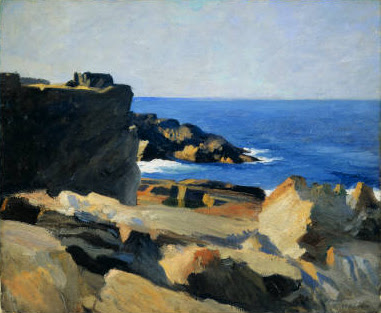Light as the Subject: An Example by Hopper
One of the things I value most highly in painting (and in life for that matter) is the enjoyment of light. Square Rock, a small oil Hopper did early in his career out on the coast of Maine that's in the Whitney Museum's big Hopper Collection, makes the dazzling light palpable in a way few painters can.
One of the particular talents Hopper has mastered was telling his viewers about the connection between the strong sunlight and the very solid and even massive forms they illuminated. If you trip and fall in a Hopper painting, you're likely to need a bandage afterwards. Bright light in his world shows us crisp and sharp edges. Against that he shines a bright, weightless spotlight on his scene. It's usually marvelous.
As the painting's title suggests, Hopper was intrigued by the geometry of the square-ish big rock at the left. But he knew to just plop it right in the center of his composition might make it overwhelm the other smaller rocks, especially since it's so different in its scale and form. To him painting was always telling a story about the precarious balance between opposites. Here he finds a second major character, an irregularly shaped rock over on the right hand side of the foreground. He makes it as different as possible from the huge, dark and cool-hued square fellow at the left. For counterpoint its sunlit surface is made just about the lightest shape in the whole painting (the only exception the small white surf in the distance).
I find my eye bounced like a ping pong ball between the opposing "paddles" of these two rocky foreground opponents. Sure there's lots of other things to enjoy- like the purposefully blended edge of the farthest waters meeting the greys of the sky. But I keep being pulled back to the foreground.
I read a quote yesterday from the contemporary painter Chuck Close where he says there's no real difference between looking at a still life set up and looking at a photograph of the same subject. The shapes are the same was his point. I happen to think Close is one of the better artists who are thought of as blue chip painters. I actually saw his first museum exhibition way back in the 1960's at Allen Art Museum at Oberlin College in Ohio where I was an art major. My art history teacher Ellen Johnson brought some of his work to campus.
Close is known for his giant enlargements of heads and especially for coming up with ingenious ways to decorate the surface of his pieces. He's good at what he does. Yet his work isn't primarily interested in capturing the feeling of light. Close works from photographs and while they're good for many things, they don't give a painter much information about what's going on in the shadows. Hopper could have used photographs, but he felt he needed to understand his subject, including the light and shadow, in a profound way.
I feel the reason Hopper was so good at making his highlights and shadows come to life so convincingly is he knew he could see more if he went outside for hours and studied the light. There are easily 10,000 different little adjustments he could have made to the hue and tone of each of his shapes. He stood there so long he could sense on a deep and intuitive level the pattern that would help his painting the most. His painting is actually a patching together of different interpretations of the light- sometimes adjusting it warmer, other places pushing it darker. An incredible amount of editing and invention went into making his painting.
What he achieved is a record of the feeling of the place and the specific character and mood of the light.
Later on in his career, after decades of on the spot painting with his portable easel, Hopper turned more to painting from his memory and his imagination. But he had a painters mind by then. It had been cultivated and nurtured by decades of close observation of the ways the world looks. He did his homework.
One last thought, a confession really. I sometimes wonder how far outside of our own direct experience we can go and still feel open to what may be unfamiliar. When I saw this painting the other day on the Bowdoin College Art Museum website (they did a cool Hopper in Maine show recently) it just stopped me in my tracks. I think it's one of the most beautifully painted little oils I've ever seen.
As I write this blog post I'm realizing this view is so much like the place where I grew up outside of Rochester, NY. My folks built a home right on the shore of Lake Ontario and I would spend hours playing down on the rocks with my friends or just by myself. It seemed heavenly. And it could easily pass for Hopper's Maine coast. I look at this Hopper oil and WHOOSH I'm eight years old again building a campfire on the beach out of driftwood. I often tell my students painting is a tool to help us feel our sometimes partly buried emotions. Maybe I should add to that they can also help us with our need for time travel.



